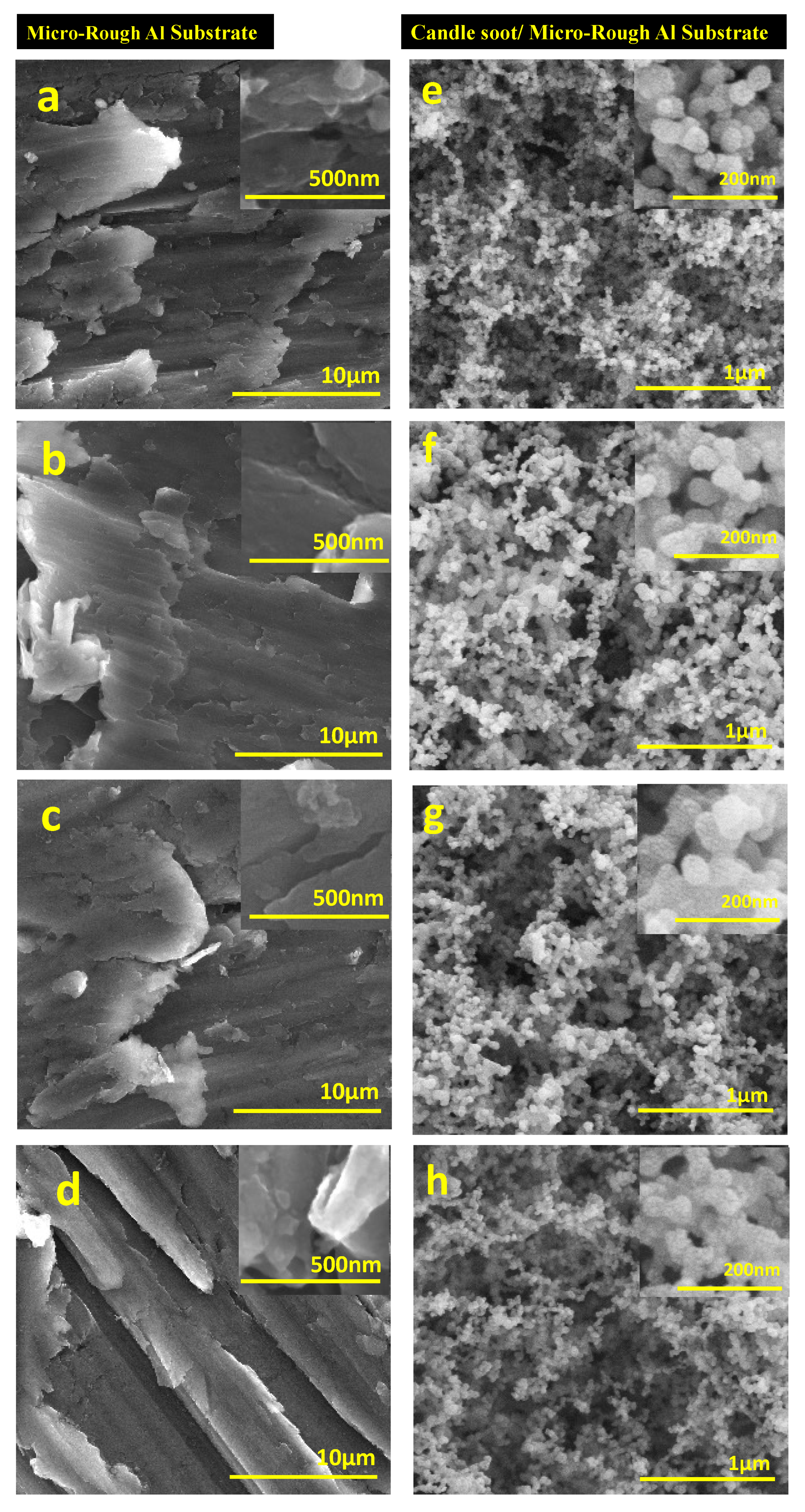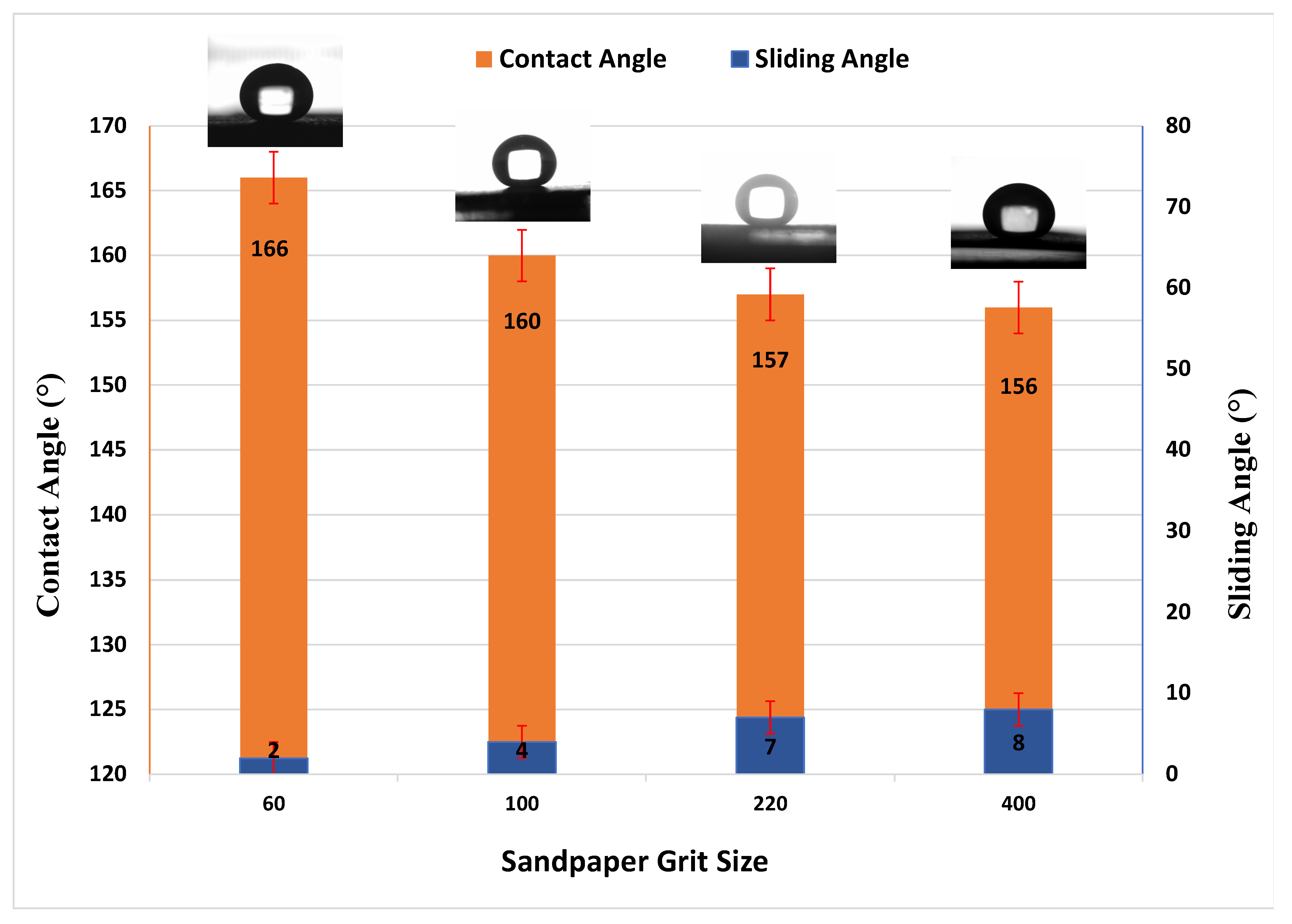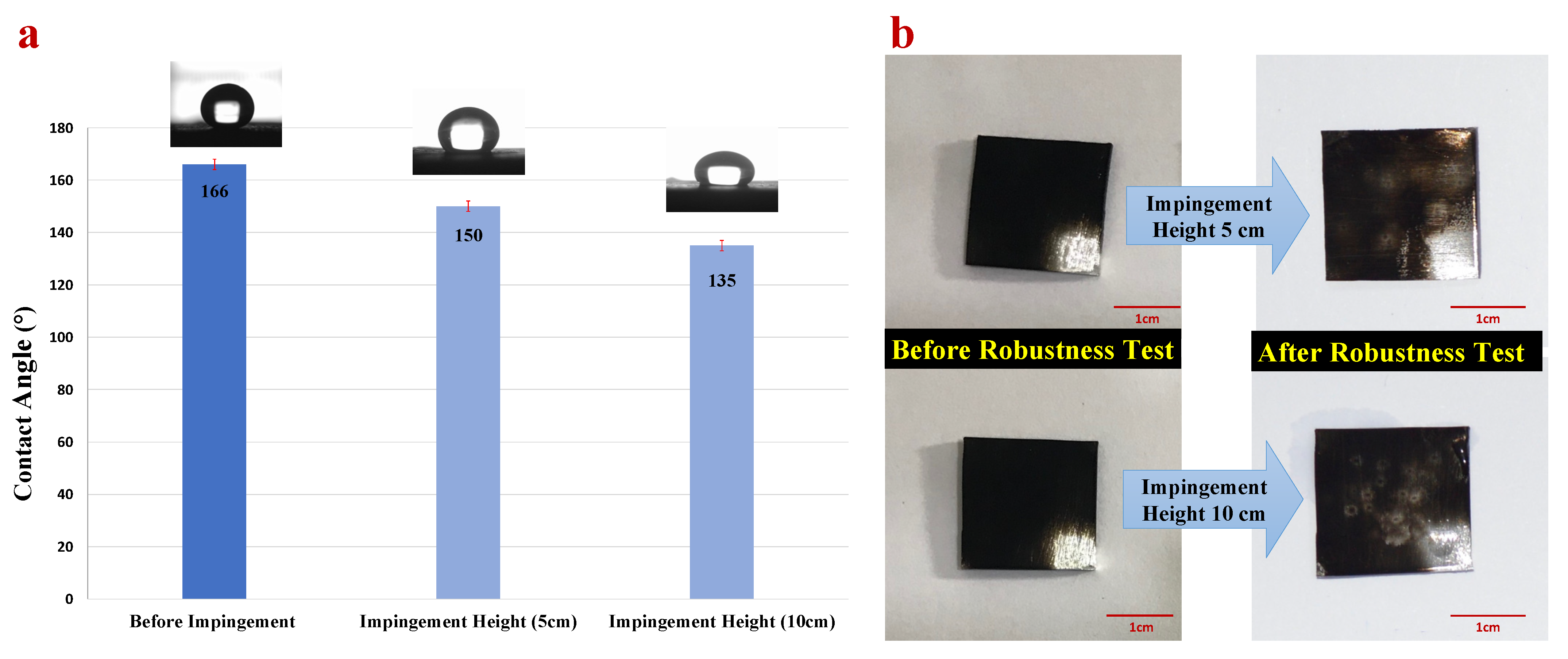Superhydrophobic Candle Soot Coating Directly Deposited on Aluminum Substrate with Enhanced Robustness
Abstract
:1. Introduction
2. Materials and Methods
2.1. Sample Preparation
2.2. Characterization
2.3. Robustness Test
3. Results and Discussion
Robustness Test
4. Conclusions
Supplementary Materials
Author Contributions
Funding
Institutional Review Board Statement
Informed Consent Statement
Data Availability Statement
Conflicts of Interest
References
- Milles, S.; Soldera, M.; Kuntze, T.; Lasagni, A.F. Characterization of self-cleaning properties on superhydrophobic aluminum surfaces fabricated by direct laser writing and direct laser interference patterning. Appl. Surf. Sci. 2020, 525, 146518. [Google Scholar] [CrossRef]
- Xu, S.; Wang, Q.; Wang, N. Eco-friendly fabrication of superhydrophobic surface with anti-corrosion by transferring dendrite-like structures to aluminum substrate. Colloids Surf. A Physicochem. Eng. Asp. 2020, 595, 124719. [Google Scholar] [CrossRef]
- Nguyen, V.-H.; Nguyen, B.D.; Pham, H.T.; Lam, S.S.; Vo, D.-V.N.; Shokouhimehr, M.; Vu, T.H.H.; Nguyen, T.-B.; Kim, S.Y.; Van Le, Q. Anti-icing performance on aluminum surfaces and proposed model for freezing time calculation. Sci. Rep. 2021, 11, 1–9. [Google Scholar] [CrossRef] [PubMed]
- Barthwal, S.; Lim, S.-H. A durable, fluorine-free, and repairable superhydrophobic aluminum surface with hierarchical micro/nanostructures and its application for continuous oil-water separation. J. Membr. Sci. 2021, 618, 118716. [Google Scholar] [CrossRef]
- Xu, C.; Shi, Z.; Wu, Z.; Zhang, F.; Gu, L.; Wang, Y.; Zhou, X.; Peng, C. Fabrication of superhydrophobic soot-like surface. In Proceedings of the 2016 IEEE International Conference on Manipulation, Manufacturing and Measurement on the Nanoscale (3M-NANO), Chongqing, China, 18–22 July 2016; pp. 400–403. [Google Scholar]
- Deng, X.; Mammen, L.; Butt, H.-J.; Vollmer, D. Candle soot as a template for a transparent robust superamphiphobic coating. Science 2012, 335, 67–70. [Google Scholar] [CrossRef] [PubMed]
- Esmeryan, K.; Radeva, E.; Avramov, I. Durable superhydrophobic carbon soot coatings for sensor applications. J. Phys. D Appl. Phys. 2015, 49, 025309. [Google Scholar] [CrossRef]
- Yang, L.; Fu, H.; Yang, C.; Tian, W.; Wu, P.; Jiang, W. Carbon soot with arbitrary wettability deposited on solid surface by ethanol flame method. Colloids Surf. A Physicochem. Eng. Asp. 2019, 578, 123576. [Google Scholar] [CrossRef]
- Zhang, B.; Duan, J.; Huang, Y.; Hou, B. Double layered superhydrophobic PDMS-Candle soot coating with durable corrosion resistance and thermal-mechanical robustness. J. Mater. Sci. Technol. 2021, 71, 1–11. [Google Scholar] [CrossRef]
- Zhang, X.; Zhao, J.; Mo, J.; Sun, R.; Li, Z.; Guo, Z. Fabrication of superhydrophobic aluminum surface by droplet etching and chemical modification. Colloids Surf. A Physicochem. Eng. Asp. 2019, 567, 205–212. [Google Scholar] [CrossRef]
- Dai, W.; Kim, S.J.; Seong, W.-K.; Kim, S.H.; Lee, K.-R.; Kim, H.-Y.; Moon, M.-W. Porous carbon nanoparticle networks with tunable absorbability. Sci. Rep. 2013, 3, 1–9. [Google Scholar] [CrossRef] [Green Version]
- Sutar, R.S.; Latthe, S.S.; Nagappan, S.; Ha, C.S.; Sadasivuni, K.K.; Liu, S.; Xing, R.; Bhosale, A.K. Fabrication of robust self-cleaning superhydrophobic coating by deposition of polymer layer on candle soot surface. J. Appl. Polym. Sci. 2021, 138, 49943. [Google Scholar] [CrossRef]
- Rico, V.J.; López-Santos, C.; Villagrá, M.N.; Espinós, J.P.; de la Fuente, G.F.; Angurel, L.A.; Borrás, A.; González-Elipe, A.N.R. Hydrophobicity, freezing delay, and morphology of laser-treated aluminum surfaces. Langmuir 2019, 35, 6483–6491. [Google Scholar] [CrossRef]
- Guo, Y.; Zhang, X.; Wang, X.; Xu, Q.; Geng, T. Wetting and tribological properties of superhydrophobic aluminum surfaces with different water adhesion. J. Mater. Sci. 2020, 55, 11658–11668. [Google Scholar] [CrossRef]
- Lu, Y.; Guan, Y.; Li, Y.; Yang, L.; Wang, M.; Wang, Y. Nanosecond laser fabrication of superhydrophobic surface on 316L stainless steel and corrosion protection application. Colloids Surf. A Physicochem. Eng. Asp. 2020, 604, 125259. [Google Scholar] [CrossRef]
- Khedir, K.R.; Kannarpady, G.K.; Ishihara, H.; Woo, J.; Ryerson, C.; Biris, A.S. Design and fabrication of teflon-coated tungsten nanorods for tunable hydrophobicity. Langmuir 2011, 27, 4661–4668. [Google Scholar] [CrossRef]
- Vilaró, I.; Yagüe, J.L.; Borrós, S. Superhydrophobic copper surfaces with anticorrosion properties fabricated by solventless CVD methods. ACS Appl. Mater. Interfaces 2017, 9, 1057–1065. [Google Scholar] [CrossRef]
- Lei, T.; Xiong, J.; Huang, J.; Zheng, T.; Cai, X. Facile transformation of soot nanoparticles into nanoporous fibers via single-step electrospinning. AIP Adv. 2017, 7, 085212. [Google Scholar] [CrossRef] [Green Version]
- Tang, Y.; Zhang, Q.; Zhan, X.; Chen, F. Superhydrophobic and anti-icing properties at overcooled temperature of a fluorinated hybrid surface prepared via a sol–gel process. Soft Matter 2015, 11, 4540–4550. [Google Scholar] [CrossRef]
- Qahtan, T.F.; Gondal, M.A.; Alade, I.O.; Dastageer, M.A. Fabrication of water jet resistant and thermally stable superhydrophobic surfaces by spray coating of candle soot dispersion. Sci. Rep. 2017, 7, 1–7. [Google Scholar] [CrossRef] [Green Version]
- Gong, A.; Zheng, Y.; Yang, Z.; Guo, X.; Gao, Y.; Li, X. Spray fabrication of superhydrophobic coating on aluminum alloy for corrosion mitigation. Mater. Today Commun. 2021, 26, 101828. [Google Scholar] [CrossRef]
- Zhao, L.; Zhao, K.; Yan, W.-G.; Liu, Z. Preparation of assembled carbon soot films and hydrophobic properties. Materials 2018, 11, 2318. [Google Scholar] [CrossRef] [PubMed] [Green Version]
- Saifaldeen, Z.S.; Khedir, K.R.; Cansizoglu, M.F.; Demirkan, T.; Karabacak, T. Superamphiphobic aluminum alloy surfaces with micro and nanoscale hierarchical roughness produced by a simple and environmentally friendly technique. J. Mater. Sci. 2014, 49, 1839–1853. [Google Scholar] [CrossRef]
- Khedir, K.R.; Saifaldeen, Z.S.; Demirkan, T.M.; Al-Hilo, A.A.; Brozak, M.P.; Karabacak, T. Robust superamphiphobic nanoscale copper sheet surfaces produced by a simple and environmentally friendly technique. Adv. Eng. Mater. 2015, 17, 982–989. [Google Scholar] [CrossRef]
- Rico, V.; Mora, J.; García, P.; Agüero, A.; Borrás, A.; González-Elipe, A.R.; López-Santos, C. Robust anti-icing superhydrophobic aluminum alloy surfaces by grafting fluorocarbon molecular chains. Appl. Mater. Today 2020, 21, 100815. [Google Scholar] [CrossRef]
- Barthwal, S.; Lim, S.-H. Rapid fabrication of a dual-scale micro-nanostructured superhydrophobic aluminum surface with delayed condensation and ice formation properties. Soft Matter 2019, 15, 7945–7955. [Google Scholar] [CrossRef]
- Milles, S.; Dahms, J.; Soldera, M.; Lasagni, A.F. Stable Superhydrophobic Aluminum Surfaces Based on Laser-Fabricated Hierarchical Textures. Materials 2021, 14, 184. [Google Scholar] [CrossRef]
- Esmeryan, K.D.; Castano, C.E.; Fedchenko, Y.I.; Mohammadi, R.; Miloushev, I.K.; Temelkov, K.A. Adjustable optical transmittance of superhydrophobic carbon soot coatings by in-situ single-step control of their physicochemical profile. Colloids Surf. A Physicochem. Eng. Asp. 2019, 567, 325–333. [Google Scholar] [CrossRef]
- Seo, K.; Kim, M. Candle-based process for creating a stable superhydrophobic surface. Carbon 2014, 68, 583–596. [Google Scholar] [CrossRef]
- Wu, S.; Du, Y.; Alsaid, Y.; Wu, D.; Hua, M.; Yan, Y.; Yao, B.; Ma, Y.; Zhu, X.; He, X. Superhydrophobic photothermal icephobic surfaces based on candle soot. Proc. Natl. Acad. Sci. USA 2020, 117, 11240–11246. [Google Scholar] [CrossRef]
- Wei, Q.; Zhu, Y.; Liu, S.; Gao, Y.; Li, X.; Shi, M.; Zhang, X.; Zhang, M. Candle Soot Coating for Latent Fingermark Enhancement on Various Surfaces. Sensors 2017, 17, 1612. [Google Scholar] [CrossRef] [Green Version]







Publisher’s Note: MDPI stays neutral with regard to jurisdictional claims in published maps and institutional affiliations. |
© 2022 by the authors. Licensee MDPI, Basel, Switzerland. This article is an open access article distributed under the terms and conditions of the Creative Commons Attribution (CC BY) license (https://creativecommons.org/licenses/by/4.0/).
Share and Cite
Hussein, H.A.; Wais, S.I.; Khedir, K.R. Superhydrophobic Candle Soot Coating Directly Deposited on Aluminum Substrate with Enhanced Robustness. Coatings 2022, 12, 202. https://doi.org/10.3390/coatings12020202
Hussein HA, Wais SI, Khedir KR. Superhydrophobic Candle Soot Coating Directly Deposited on Aluminum Substrate with Enhanced Robustness. Coatings. 2022; 12(2):202. https://doi.org/10.3390/coatings12020202
Chicago/Turabian StyleHussein, Hussein Ali, Sabah Ibrahim Wais, and Khedir R. Khedir. 2022. "Superhydrophobic Candle Soot Coating Directly Deposited on Aluminum Substrate with Enhanced Robustness" Coatings 12, no. 2: 202. https://doi.org/10.3390/coatings12020202





